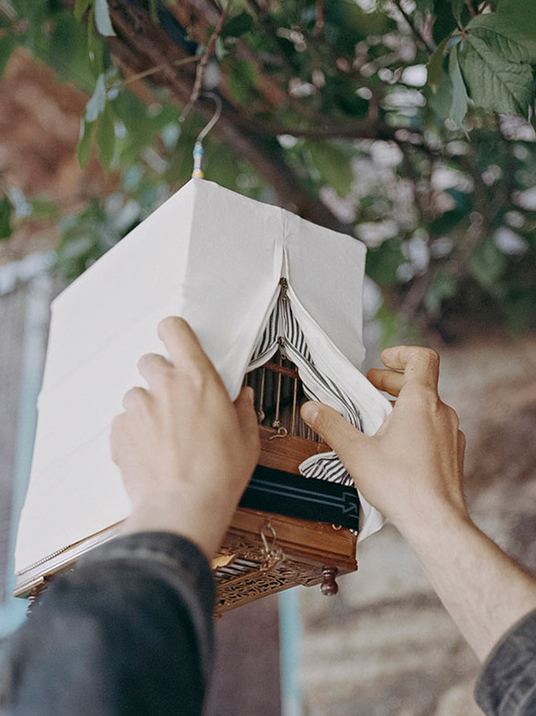"for birds sake," an online exhibition by Cemre Yesil and Maria Sturm, begins with a statement offering a fascinating bit of history and contemporary politics:
Since the time of the Ottoman Empire, Istanbul has been a very important city for aviculture. The city’s geographical location for bird migration has led to the establishment of a huge culture devoted to birds and their care.
The photographers’ statement goes on to describe the purpose of the photographs:
This work is about the birdmen of Istanbul and focuses on the shrouded relationship between the bird and the birdman, one full of contradictions of love, possession and pleasure.
an illegal tradition
an addiction
a meditation
Something they need in order to feel good.
The first photograph shows two hands pulling apart curtains that hang over a birdcage. We can see past the door's grill, but we see nothing except darkness. This is as close to a bird as the exhibit allows us. "A white box that contains darkness," the statement says. The succeeding images do not pull away the curtains but speak gracefully of songbirds and their keepers--or should we call them patrons?
Objects of bird care--brightly colored feeding and watering containers, two beautiful Turkish tea glasses with plastic snaps for cage attachment, twine, and other paraphernalia--appear against black backgrounds that push the objects toward us.
The cages are a central theme in the photographic sequence. These men who cultivate beautiful song are masters of simple but elegant design. Cloth and attachments speak of eyes that find beauty in both music and color and texture.
Music echoes in two ironic cages--old vinyl record holders converted from one kind of song protection to another--birdcages.
The birdmen that we see are large, small, trim, pudgy--the variety of people you encounter on any Istanbul sidewalk. Nothing remarkable marks them as bird or song lovers. They are "Men smelling like newspapers and turkish tea." I saw only one birdman marked as a birder, a beautifully composed young man wearing a short black shirt. The shot is cropped at the shoulder, muscular arm akimbo to the waist and forming a large triangular negative space between arm/hand and torso. The arm has two tattoos. On the shoulder is a beguiling geisha-like figure disappearing around the limb. On the forearm is a tattoo of a bird perched on a limb.
Placement of the images is carefully considered. Some of the images sit by themselves surrounded by plenty of white space, while others hang close together, pairs that invite consideration of image relationship, formal or narrative.
A mutual madness between photographers and birdmen; us; trying to understand this passion fitted into cages, and them; trying to understand our urge to take pictures of these ‘ordinary’ cages.
The political side of the tradition is explained simply:
Many diverse social platforms exist devoted to the keeping and breeding of birds. Today this culture is in danger; keeping songbirds such as goldfinches and greenfinches, in particular, may soon vanish due to Turkey’s adaptation to criteria for European Union candidacy.
The slow dance between Turkey and the EU ought to be a poetic movement; otherwise it will atrophy from what Ezra Pound described as poetry moving too far from the music.
Protection of wildlife is vital, but so is the protection of beautiful cultural treasures. Brussels needs to listen to the music, the music preserved and bequeathed by the birdmen of Istanbul.
The exhibition by Yesil and Sturm is visual poetry toward that end.
______
Images provided by Cemre Yesil and Maria Sturm who retain all rights. The show resides on Yesil's website, http://www.cemreyesil.com/. Maria Sturm's site is available at http://www.mariasturm.com/
______
Images provided by Cemre Yesil and Maria Sturm who retain all rights. The show resides on Yesil's website, http://www.cemreyesil.com/. Maria Sturm's site is available at http://www.mariasturm.com/










